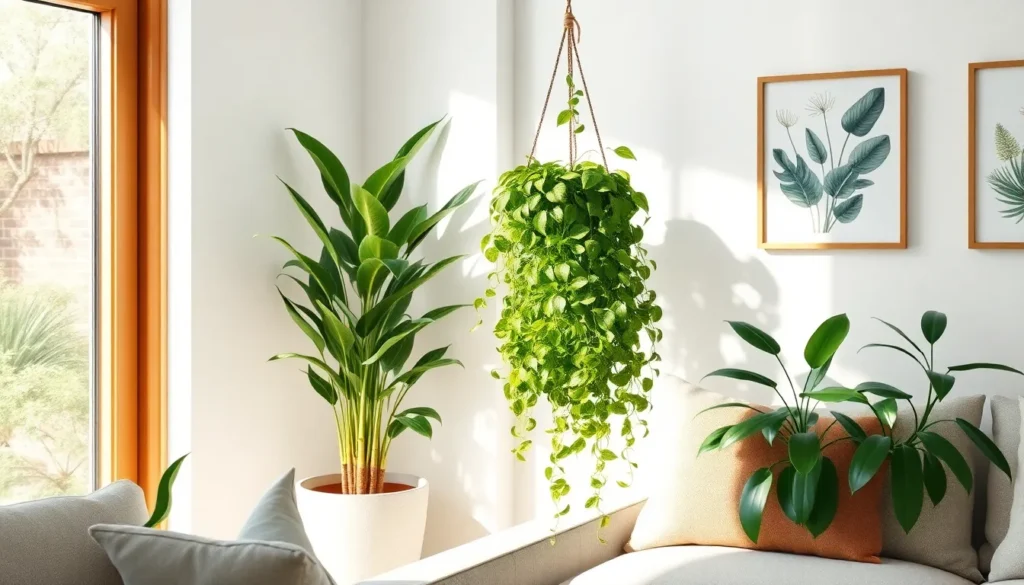We’ve all experienced that moment when we step into a room and notice those awkward empty corners that seem impossible to decorate. These forgotten spaces often become catch-alls for random items or simply remain bare and uninviting. But what if we told you there’s a simple solution that’ll transform these neglected areas into stunning focal points?
Corner plants are the secret weapon that interior designers swear by for creating cohesive and vibrant living spaces. They’re not just decorative elements – they’re natural air purifiers that breathe life into previously wasted square footage. Whether you’re dealing with a dark corner in your living room or a bright spot near your bedroom window these green companions can completely change your home’s atmosphere.
The best part? You don’t need a green thumb or extensive gardening knowledge to master corner plant decor. We’ll show you exactly how to choose the perfect plants and styling techniques that’ll make your corners the envy of every visitor.
Choose Low-Light Corner Plants That Thrive in Dim Spaces
Most corners in our homes receive minimal natural light, making plant selection crucial for success. We’ve identified the best low-light plants that flourish in these challenging conditions while adding natural beauty to neglected spaces.
Snake Plants for Minimal Maintenance
Snake plants excel in dim corners where other houseplants struggle to survive. These architectural beauties feature thick, upright leaves with striking yellow edges that create visual interest without requiring direct sunlight. Watering becomes incredibly simple since snake plants prefer dry soil between waterings, making them perfect for busy homeowners or frequent travelers.
Growth patterns remain compact and vertical, making snake plants ideal for narrow corner spaces where floor area is limited. We recommend the ‘Laurentii’ variety for its classic golden striping or ‘Moonshine’ for its silvery green appearance. Placement options include floor corners, plant stands, or elevated surfaces where their sculptural form can be appreciated.
ZZ Plants for Ultimate Durability
ZZ plants represent the ultimate low-maintenance corner solution for homes with challenging lighting conditions. Their glossy, dark green leaves reflect available light beautifully while requiring minimal care throughout the year. Drought tolerance makes these plants nearly indestructible, surviving weeks without water in dim corner locations.
Size variations allow us to choose from compact tabletop versions to larger floor specimens reaching 3 feet tall. Propagation becomes effortless since ZZ plants multiply through underground rhizomes, giving us new plants to expand our corner decor. Air purifying qualities add functional benefits while the plant’s natural resilience ensures long-term success in low-light environments.
Pothos Varieties for Trailing Beauty
Pothos plants bring cascading elegance to corner spaces while thriving in low-light conditions throughout our homes. Trailing vines create dramatic vertical displays when placed on tall plant stands, bookers, or hanging from ceiling hooks in corner areas. Heart-shaped leaves come in multiple varieties including ‘Golden Pothos’ with yellow variegation and ‘Marble Queen’ with white and green patterns.
Adaptability makes pothos suitable for both climbing and trailing presentations in corner decor arrangements. We can train these plants to climb moss poles for upward growth or allow them to cascade naturally from elevated positions. Root propagation in water allows us to create new plants easily, expanding our corner plant collection while maintaining consistent styling throughout different rooms.
Select the Right Size Planters for Your Corner Space
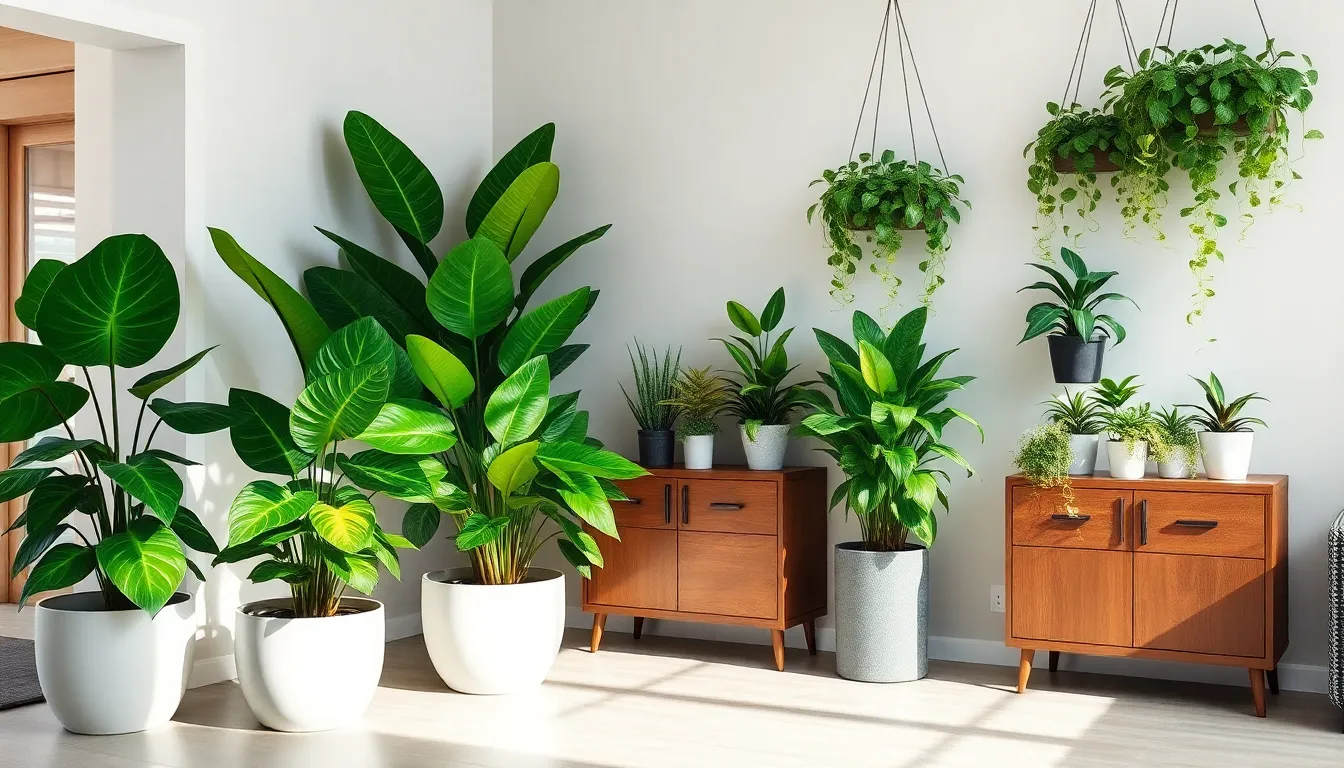
Choosing appropriately sized planters transforms your corner from an awkward empty space into a balanced design element. We recommend considering both the scale of your room and the mature size of your chosen plants when selecting containers.
Floor Planters for Large Statement Plants
Large floor planters create dramatic impact with bold plants like fiddle leaf figs, bird of paradise, dracaena, palms, or monstera. These substantial containers provide the root space needed for taller plants while anchoring your corner display with visual weight. We suggest selecting planters that measure at least 12-14 inches in diameter for medium statement plants and 16-20 inches for larger specimens.
Statement plants thrive when their containers match their scale, preventing the top-heavy appearance that occurs with oversized plants in small pots. Floor planters also eliminate the need for additional furniture pieces, making them perfect for minimalist corner arrangements. Consider materials like ceramic, fiberglass, or woven baskets that complement your existing decor while providing adequate drainage.
Elevated Plant Stands for Multi-Level Display
Plant stands maximize vertical space by creating layered arrangements that showcase multiple plants at different heights. We recommend using stands of varying heights (12, 18, and 24 inches) to create visual depth and prevent your corner from appearing flat. This approach works especially well for displaying trailing plants like pothos alongside your taller statement pieces.
Multi-level displays allow us to combine different plant sizes and textures in one cohesive arrangement. Medium-sized plants on elevated stands can fill the middle visual space between large floor plants and hanging varieties. Consider wooden plant stands for natural warmth or metal options for modern aesthetics, ensuring they’re sturdy enough to support both plant and planter weight.
Hanging Planters for Vertical Interest
Hanging planters use ceiling space to add dimension without consuming valuable floor area. We recommend positioning them at varying heights to create visual movement, with trailing plants like spider plants or pothos cascading naturally downward. This technique draws the eye upward and makes corners appear larger and more ever-changing.
Vertical arrangements work particularly well in smaller corners where floor space is limited but you still want lush greenery. Install ceiling hooks or wall-mounted brackets at different heights to create a floating garden effect. Macrame hangers or sleek metal hanging planters can complement your room’s style while supporting healthy plant growth through proper drainage systems.
Position Your Corner Plants for Optimal Growth
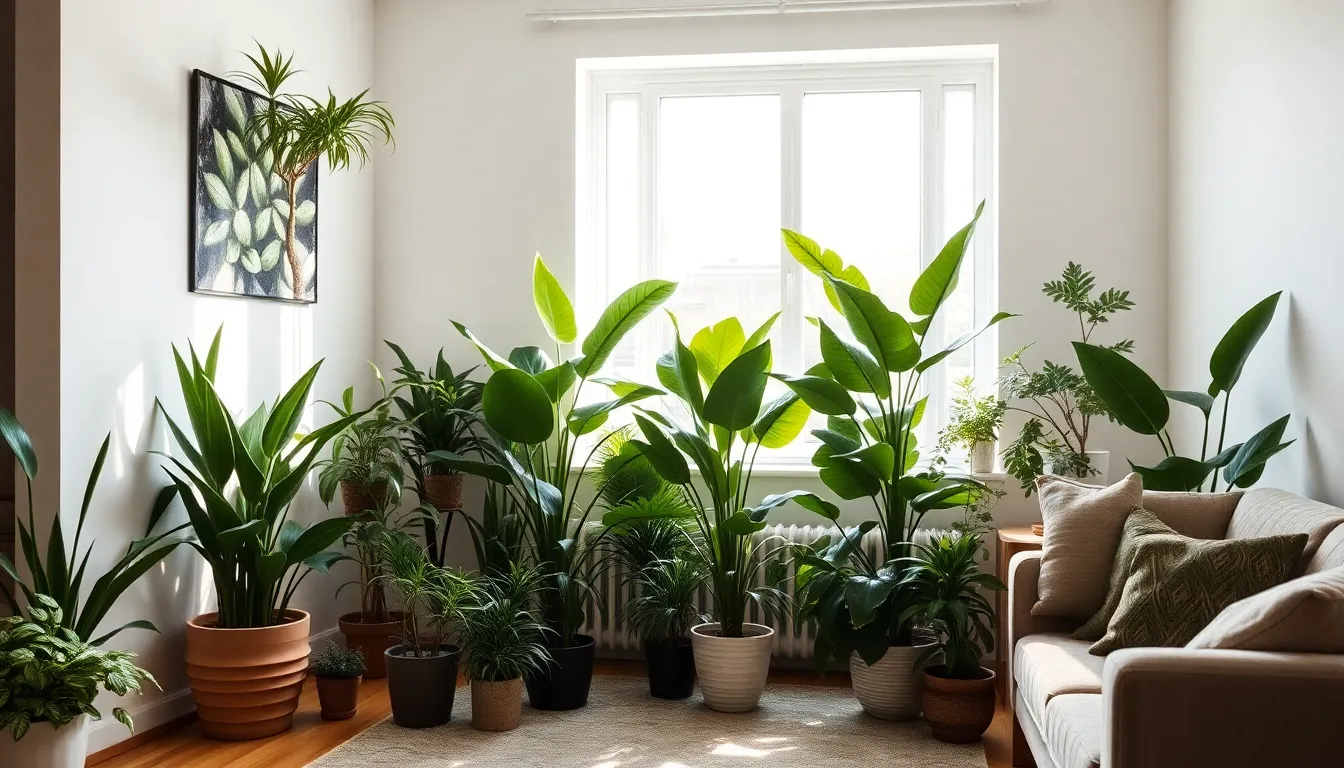
Creating the perfect corner plant arrangement goes beyond simply choosing beautiful containers and healthy plants. We need to strategically position our greenery to ensure it thrives while improving our indoor spaces.
Understanding Light Requirements and Window Proximity
Light serves as the foundation for successful corner plant placement in our homes. We should position sun-loving plants like tomatoes near windows or screen doors where they’ll receive ample natural sunlight throughout the day. Tall floor plants perform exceptionally well when placed close to large windows or sliding doors, where they benefit from abundant natural light while creating a seamless connection between our indoor and outdoor spaces.
Different plant sizes require exact positioning strategies to maximize their light exposure and aesthetic appeal. We can place tall plants near windows or beside sofas where they’ll catch the most light. Medium-sized plants work beautifully on shelves or bookcases where they’re elevated toward light sources. Small plants thrive on coffee tables or in hanging pots where they can still access adequate illumination while adding charm to our decor.
Creating Proper Air Circulation Around Plants
Airflow plays a crucial role in maintaining healthy corner plants and preventing common plant diseases. We must maintain at least 6 to 8 inches of clearance around each plant to ensure proper air circulation and prevent overcrowding. This spacing prevents moisture buildup that can lead to fungal issues and root rot.
Strategic distribution throughout our rooms creates better air movement than clustering plants together. We should avoid placing multiple bushy or spherical plants on the same furniture piece like benches, as this restricts airflow and creates visual competition. Instead, we can arrange plants in odd numbers and spread them across different areas of the room for balanced air circulation and enhanced visual interest.
Maintaining Safe Distance from Heat Sources
Heat sources pose important threats to our corner plants’ health and longevity. We need to keep our plants away from radiators, fireplaces, and heating vents that can quickly dry out foliage or damage delicate root systems. These heat sources create harsh microenvironments that stress plants and disrupt their natural moisture balance.
Positioning plants at safe distances from heat sources helps maintain proper humidity levels around our indoor greenery. We should place pots where they won’t experience sudden temperature fluctuations or direct heat exposure. This careful positioning protects our plants from heat stress while allowing them to contribute their natural beauty to our corner spaces without compromising their health.
Design Corner Plant Arrangements That Complement Your Decor Style
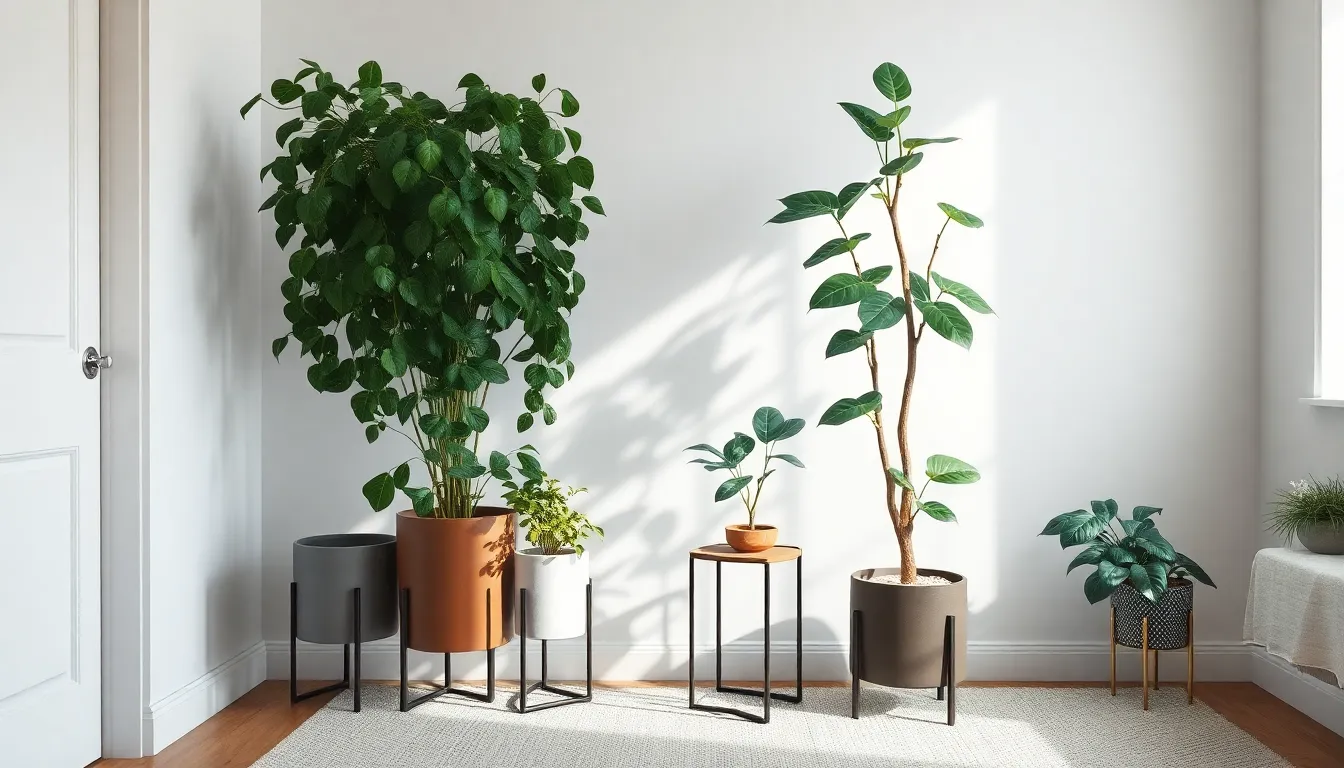
Creating corner plant displays that harmonize with your existing interior design transforms awkward spaces into stunning focal points. We’ll explore three distinct styling approaches that maximize both visual impact and plant health.
Modern Minimalist Corner Setups
Geometric plant stands with clean lines define the modern minimalist aesthetic. Metal stands in brass or black finishes create sleek foundations that complement contemporary decor. We recommend choosing stands with simple, angular shapes that won’t compete with your plants for attention.
Restrained plant selection keeps the focus on form and function. Pair your geometric stands with draping plants like pothos, architectural ferns, or sculptural succulents. Plain white or muted tone pots enhance the minimal look without adding visual clutter to your corner space.
Tall statement plants add vertical drama to minimalist corners. Fiddle leaf figs and dracaena varieties create striking silhouettes that draw the eye upward. Balance these larger plants with smaller companions on multi tiered stands to maintain the clean, organized appearance that defines this style.
Faux botanicals work perfectly when drainage isn’t available. Some corner plant stands lack proper drainage holes, making artificial plants an elegant solution. Choose high quality faux options that mimic real plant textures and colors for authentic looking displays.
Bohemian Jungle Corner Vibes
Layered greenery with varied textures creates the quintessential boho jungle feel. Mix trailing vines like pothos with large leaf plants such as monstera and feathery palms. This abundant approach embraces the organic, lived in aesthetic that makes bohemian spaces so inviting.
Open slatted or faux wicker stands add warmth to boho corners. These natural materials complement the relaxed, earthy vibe while supporting your plant collection. Choose stands that showcase the casual, handcrafted elements typical of bohemian design.
Eclectic pot colors in cool and warm tones enhance the vibrant atmosphere. Mix terracotta, ceramic, and woven baskets in various sizes and colors. This diversity adds visual interest while reflecting the collected over time feeling that defines boho style.
Hanging wall planters maximize vertical space for dense jungle displays. Install corner shelves at different heights to create multiple plant levels. This technique allows you to showcase diverse plant varieties while maintaining the lush, abundant look that characterizes bohemian jungle corners.
Traditional Elegant Plant Displays
Pedestal type plant stands in brushed brass create sophisticated displays. These classic stands elevate your plants both literally and figuratively, adding stately elegance to traditional interiors. Burnished finishes complement formal decor while providing stable support for larger plants.
Statement plants like ficus and peace lilies anchor elegant corner arrangements. Olive trees in classic ceramic pots offer refined appeal and visual drama. These larger specimens create focal points that command attention while maintaining the dignified atmosphere of traditional spaces.
Meticulous plant care ensures your elegant displays remain visually stunning. Regular watering schedules and occasional use of indoor grow lights keep foliage healthy and vibrant. Well maintained plants reflect the attention to detail that traditional elegant style demands.
Balanced arrangements prevent overcrowding while maximizing impact. Pair tall statement plants with a few smaller, well chosen companions. This approach maintains the uncluttered sophistication that defines traditional elegant plant displays while adding subtle variety to your corner arrangement.
Incorporate Decorative Elements Around Your Corner Plants
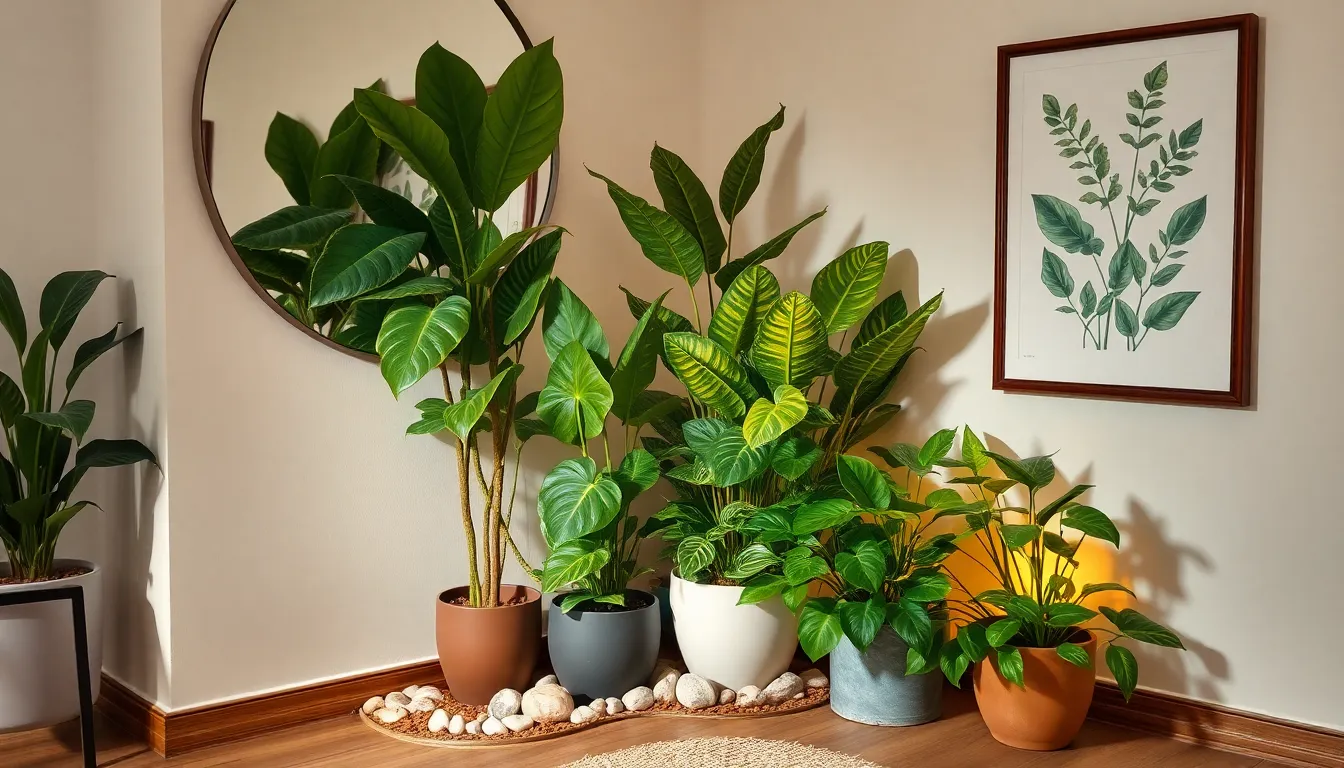
We can elevate our corner plant displays beyond just placing pots in empty spaces by thoughtfully adding complementary decorative elements that enhance both the plants and the overall room aesthetic.
Adding Decorative Stones and Mulch
Decorative stones create texture and visual polish at the base of our corner plants while serving practical purposes. White pebbles or colored gravel provide striking contrast against green foliage, making plants appear more vibrant and intentional in their placement. We’ll find that stones like river rocks or lava stones help define the plant area as a distinct feature rather than an afterthought.
Mulch offers another excellent option for improving our corner displays while maintaining soil moisture and cleanliness around plant bases. Organic mulches like bark chips or coconut coir create natural, earthy tones that complement most interior styles. This decorative layer prevents soil from scattering during watering and gives our corner arrangements a professionally landscaped appearance.
Including Complementary Artwork and Mirrors
Mirrors strategically placed near our plant corners visually extend the space and reflect natural light onto the greenery, making dim corners appear brighter and more spacious. We can position mirrors at angles that capture and redirect available light, helping our plants thrive while creating depth in tight spaces. Large mirrors work particularly well behind statement plants, doubling their visual impact.
Botanical themed artwork creates cohesive corner displays that reinforce our green design theme throughout the room. Abstract pieces featuring green tones or nature inspired prints complement plant colors without competing for attention. We should choose artwork that scales appropriately with our plants, ensuring neither element overwhelms the corner space.
Using Accent Lighting for Evening Ambiance
Spotlights and LED grow lights serve dual purposes by highlighting our corner plants while supporting their health in low light conditions. We can install adjustable track lighting or use portable LED spotlights to create dramatic emphasis on statement plants like fiddle leaf figs or bird of paradise. Grow lights benefit plant health during darker months while maintaining the corner’s visual appeal after sunset.
String lights add warmth and coziness to our plant corners, creating inviting evening atmospheres that draw people into previously overlooked spaces. Soft, indirect lighting from table lamps or floor lamps positioned near our corner displays creates gentle illumination that showcases plant silhouettes without harsh shadows. We’ll achieve the most appealing results by layering different light sources at varying heights around our corner plant arrangements.
Maintain Your Corner Plants for Long-Term Indoor Success
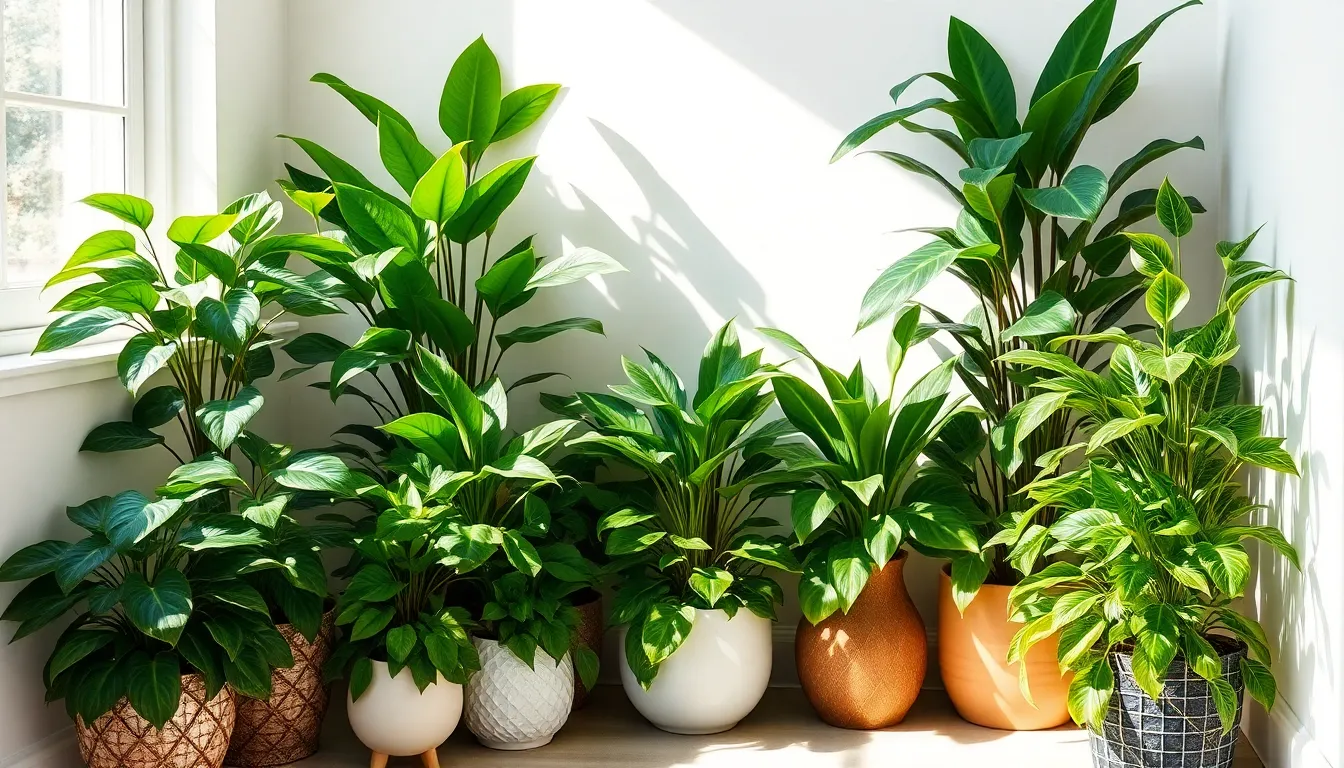
Creating beautiful corner displays is just the beginning of your indoor plant journey. We need consistent care routines to keep our corner plants thriving and looking their best year after year.
Establishing Proper Watering Schedules
Watering schedules form the foundation of successful corner plant care. Most plants thrive when we water them after the top inch of soil becomes dry, while succulents and desert plants need completely dry soil between waterings. We’ve found that overwatering causes more plant deaths than underwatering, with yellowing leaves signaling too much moisture and crispy brown edges indicating drought stress.
Corner plants often have different watering needs based on their light exposure. Plants receiving less light in dim corners typically need water less frequently than those in brighter spots. We recommend checking soil moisture with your finger rather than following rigid schedules, as environmental factors like humidity and temperature affect water uptake rates.
Proper watering technique ensures even moisture distribution throughout the root system. We water slowly around the entire base of each plant rather than concentrating water in one spot, allowing the soil to absorb moisture gradually. This method prevents water from running off dry soil and ensures all roots receive adequate hydration.
Rotating Plants for Even Growth
Rotating plants prevents the lopsided growth that commonly affects corner displays. Indoor plants naturally grow toward their primary light source, causing uneven development when light comes from only one direction. We turn our corner plants a quarter turn every week to ensure all sides receive equal light exposure over time.
Strategic rotation maintains the structural symmetry essential for attractive corner displays. Plants that aren’t rotated develop leggy stems on their shadowed sides and dense growth toward the light, creating an unbalanced appearance. We’ve noticed that consistent rotation produces fuller, more aesthetically pleasing plants that enhance rather than detract from our corner arrangements.
Rotation schedules vary based on plant growth rates and light conditions. Fast growing plants like pothos and ZZ plants benefit from weekly rotation, while slower growing specimens like snake plants need turning only every two weeks. We mark rotation dates on our plant care calendars to maintain consistency across our entire corner plant collection.
Pruning and Grooming for Healthy Appearance
Regular pruning keeps corner plants tidy and promotes vigorous new growth. We remove dead leaves and spent flowers immediately to prevent disease issues and pest infestations from spreading throughout our displays. Cutting back leggy or sparse branches encourages fuller, bushier growth patterns that look more attractive in corner settings.
Grooming practices enhance both plant health and visual appeal in our corner displays. We dust leaves weekly with a gentle sponge or give plants light showers to clear dust from leaf pores, improving photosynthesis efficiency. Clean leaves also reflect more light, making corner areas appear brighter and more vibrant.
Systematic pruning schedules prevent corner plants from outgrowing their designated spaces. We trim overgrown branches and trailing vines before they overwhelm nearby furniture or create cramped conditions. This proactive approach maintains the balanced proportions essential for successful corner plant arrangements while promoting healthier growth patterns throughout the growing season.
Troubleshoot Common Corner Plant Problems
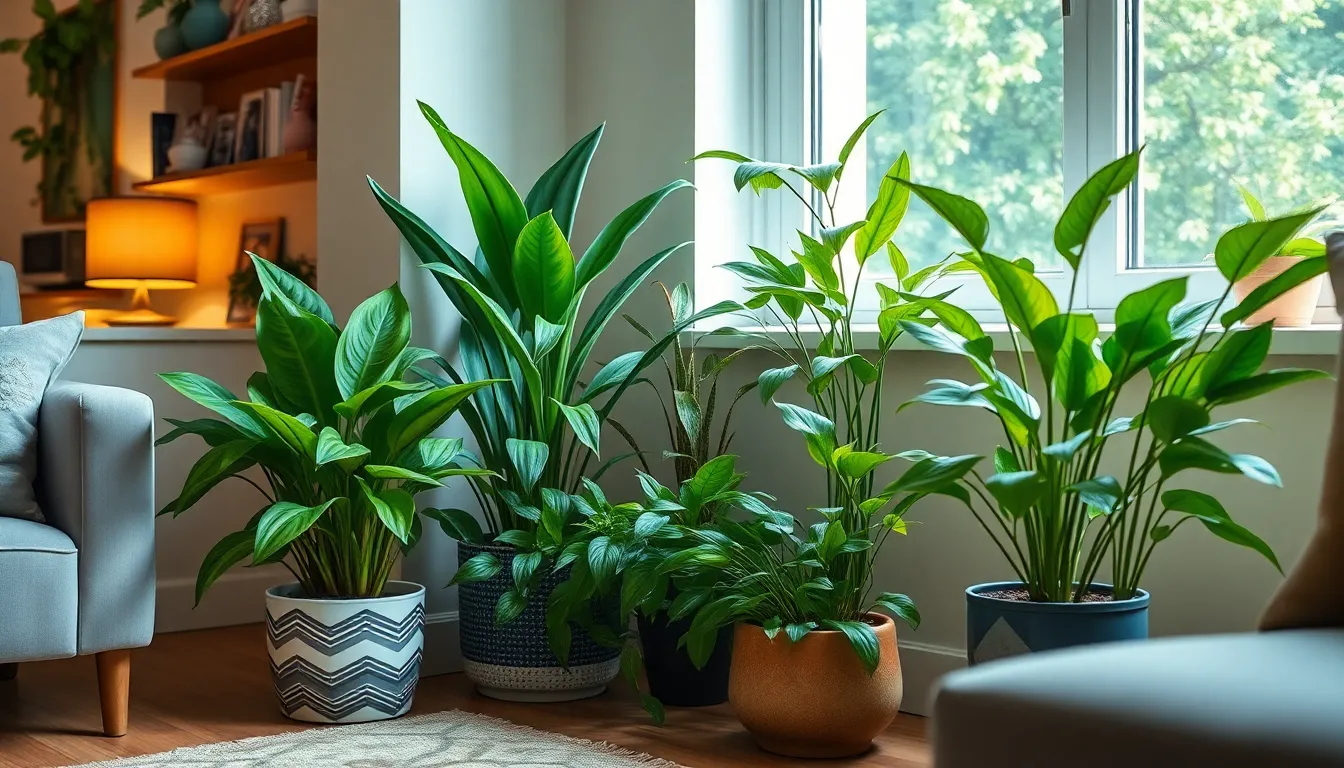
Even the most carefully selected corner plants can encounter challenges that affect their health and appearance. We’ll help you identify and resolve the most common issues that arise in these indoor spaces.
Addressing Yellowing Leaves and Overwatering
Yellow leaves signal overwatering, which ranks as the leading cause of corner plant decline. We recommend reducing your watering frequency immediately when you notice this symptom, as excess moisture creates conditions for root rot to develop.
Check your drainage system by ensuring pots have adequate holes and well-draining soil mixtures. Plants sitting in waterlogged conditions cannot absorb nutrients properly, leading to the telltale yellow discoloration we often see in corner displays.
Adjust pot sizes to match your plant’s current root system, as oversized containers retain too much moisture between waterings. We suggest using containers that allow roughly one inch of space around the root ball for optimal water management.
Test soil moisture by inserting your finger one inch deep before each watering session. Corner plants typically need water only when this top layer feels completely dry to the touch.
Managing Pest Issues in Indoor Environments
Spider mites thrive in the low humidity conditions common to indoor corners, appearing as tiny red or brown specks on leaf undersides. We recommend increasing humidity around affected plants using pebble trays or regular misting schedules.
Aphids cluster on new growth and leaf joints, sucking plant juices and leaving behind sticky honeydew residue. Apply neem oil sprays every three days until the infestation clears, ensuring you coat both leaf surfaces thoroughly.
Scale insects attach themselves to stems and leaves, appearing as small brown or white bumps that resist easy removal. We suggest using rubbing alcohol on cotton swabs to remove individual scales, followed by insecticidal soap treatments.
Isolate new plants for two weeks before placing them in your corner displays, as this quarantine period prevents pest introduction to established collections. Regular leaf cleaning with damp cloths also removes dust and early pest colonies.
Dealing with Limited Light and Poor Growth
Corner locations receive significantly less natural light than windowsill positions, often causing slow growth and elongated stems in light hungry species. We recommend selecting shade tolerant varieties like snake plants, pothos, or ZZ plants for these challenging spots.
Supplement natural lighting with grow lights positioned 12 to 18 inches above plant canopies, running them for 8 to 12 hours daily during growing seasons. LED grow lights consume less energy while providing the full spectrum plants need for photosynthesis.
Rotate plants weekly by giving them quarter turns to ensure all sides receive equal light exposure and prevent lopsided growth patterns. This simple practice keeps corner plants developing evenly even though their fixed positioning.
Prune leggy growth by cutting back elongated stems to encourage bushier development and redirect energy to healthy foliage. We trim just above leaf nodes or junction points where new growth naturally emerges.
Conclusion
We’ve shown you how corner plants can completely transform those forgotten spaces in your home. With the right plant selection proper positioning and thoughtful styling you’ll create stunning focal points that breathe life into any room.
Remember that success comes from understanding your exact corner conditions and choosing plants that thrive in those environments. Whether you prefer minimalist elegance or bohemian abundance there’s a corner plant solution that matches your style.
Start small with one or two resilient plants like snake plants or pothos then gradually build your corner garden as you gain confidence. With regular care and attention your corner plants will reward you with years of natural beauty and improved air quality.
Your empty corners are waiting to become the most admired spots in your home.
Frequently Asked Questions
What are the best plants for dark corners in my home?
Snake plants, ZZ plants, and pothos varieties are ideal for low-light corners. These resilient plants thrive in dim conditions with minimal maintenance. Snake plants add vertical interest, ZZ plants are nearly indestructible, and pothos offer beautiful trailing foliage that cascades elegantly from elevated positions.
How do I choose the right size planter for corner plants?
Select large floor planters for statement plants like fiddle leaf figs to create bold focal points. Use elevated plant stands for multi-level displays that add visual depth. For smaller corners, hanging planters maximize vertical space without cluttering the floor area while maintaining proper scale.
How often should I water my corner plants?
Water most corner plants when the top inch of soil feels dry to your finger. Avoid rigid schedules and instead check soil moisture regularly. Water slowly around the plant’s base for even distribution, and remember that overwatering is more harmful than underwatering for most indoor plants.
Why are my corner plant leaves turning yellow?
Yellow leaves typically indicate overwatering, the most common corner plant problem. Reduce watering frequency and ensure your planters have proper drainage holes. Check that soil isn’t staying soggy, and consider moving the plant to a spot with better air circulation to prevent root rot.
How can I style corner plants to match my home decor?
For modern minimalist styles, use geometric stands with simple plant selections. Bohemian looks embrace layered greenery with eclectic pot colors. Traditional elegant displays feature pedestal stands with well-maintained plants. Add decorative stones, mirrors, or accent lighting to enhance the overall aesthetic appeal.
Do corner plants really help purify indoor air?
Yes, corner plants act as natural air purifiers while adding aesthetic value to neglected spaces. They absorb toxins and release oxygen, improving your home’s air quality. Plants like snake plants and pothos are particularly effective at filtering common indoor pollutants while thriving in low-light corner conditions.
How do I prevent my corner plants from growing lopsided?
Rotate your plants a quarter turn every week to ensure all sides receive equal light exposure. This prevents lopsided growth toward light sources. Regular rotation promotes balanced, symmetrical plant development and maintains an attractive appearance in your corner display arrangement.
What should I do about pests on my corner plants?
Common indoor plant pests include spider mites, aphids, and scale insects. Inspect plants regularly and isolate affected ones immediately. Use insecticidal soap or neem oil treatments, increase humidity, and ensure proper air circulation. Regular leaf cleaning and inspection help prevent pest infestations before they spread.

